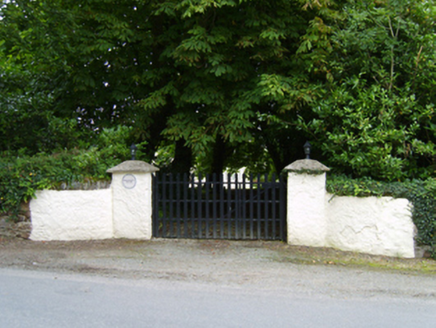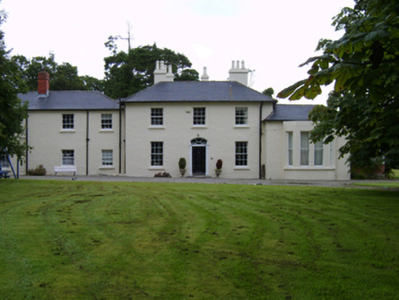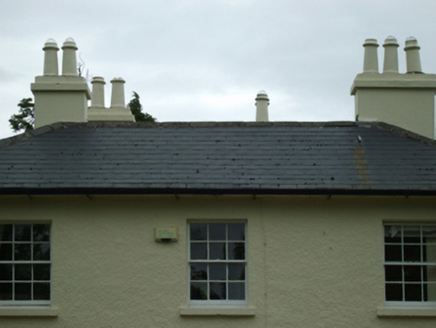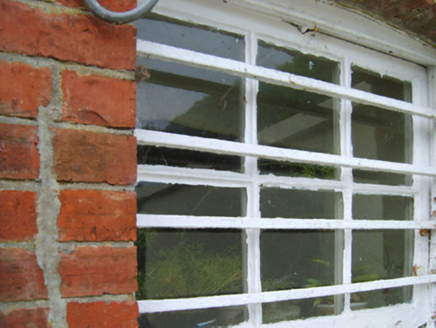Survey Data
Reg No
15701213
Rating
Regional
Categories of Special Interest
Architectural, Artistic, Historical, Social
Previous Name
Kiltennell Rectory
Original Use
Rectory/glebe/vicarage/curate's house
In Use As
House
Date
1811 - 1837
Coordinates
320164, 158648
Date Recorded
08/02/2007
Date Updated
--/--/--
Description
Detached three-bay (three-bay deep) two-storey Church of Ireland glebe house, extant 1837, on a square plan with three-bay two-storey rear (east) elevation; two-bay two-storey wing (north); single-bay single-storey double-pile advanced end bay (south). Occupied, 1901; 1911. Sold, 1972. Hipped slate roof on a U-shaped plan; hipped slate roof (north); hipped double-pile (M-profile) slate roof (south), clay ridge tiles, rendered chimney stacks having stepped capping supporting terracotta or yellow terracotta tapered pots, and cast-iron rainwater goods on rendered eaves retaining cast-iron octagonal or ogee hoppers and downpipes. Roughcast walls. Camber- or segmental-headed central door opening with cut-granite step, timber doorcase with panelled pilasters supporting shallow cornice, and concealed dressings framing timber panelled door having fanlight. Square-headed window openings including square-headed window openings to rear (east) elevation with cut-granite sills, and concealed dressings framing six-over-six timber sash windows without horns with six-over-six (ground floor) or one-over-one (first floor) timber sash windows to rear (east) elevation. Square-headed or paired square-headed window openings (north) with cut-granite sills, and concealed dressings framing six-over-six (ground floor) or six-over-three (first floor) timber sash windows. Square-headed window opening (south) with cut-granite sill, and concealed dressings framing one-over-one timber sash windows. Interior including (ground floor): hall retaining carved timber surround to window opening framing timber panelled shutters on panelled risers with carved timber surrounds to door openings framing timber panelled doors, and moulded plasterwork cornice to ceiling; library (north-west) retaining carved timber surround to door opening framing timber panelled door with carved timber surround to window opening framing timber panelled shutters on panelled risers, chimneypiece, and picture railing below ceiling; reception room (east) retaining carved timber surround to door opening framing timber panelled door with carved timber surrounds to window openings framing timber panelled shutters on panelled risers, cut-veined white marble Classical-style chimneypiece, and picture railing below plasterwork cornice to ceiling centred on plasterwork ceiling rose; dining room (south-east) retaining carved timber surround to door opening framing timber panelled door with carved timber surrounds to window openings framing timber panelled shutters on panelled risers, cut-black marble Classical-style chimneypiece, and picture railing below moulded plasterwork cornice to ceiling; drawing room (south) retaining carved timber surround to door opening framing timber panelled door with carved timber surrounds to window openings framing timber panelled shutters on panelled risers, Classical-style chimneypiece, and picture railing below moulded plasterwork cornice to ceiling centred on "Acanthus" ceiling rose in decorative plasterwork frame; and carved timber surrounds to door openings to remainder framing timber panelled doors with carved timber surrounds to window openings framing timber panelled shutters. Set in landscaped grounds with roughcast piers to perimeter having truncated pyramidal capping supporting timber gates.
Appraisal
A glebe house representing an important component of the early nineteenth-century built heritage of the outskirts of Courtown with the architectural value of the composition, one 'lately [erected] at the joint expense of the Earl of Courtown [James George Stopford (1765-1835)] and the Reverend F. Owen [Reverend Roger Carmichael Owen (1756-1843)]' (Lewis 1837 II, 213), confirmed by such attributes as the compact plan form centred on a restrained doorcase showing a stylised fanlight; and the diminishing in scale of the openings on each floor producing a graduated visual impression with the principal "apartments" defined by multipartite glazing patterns: meanwhile, aspects of the composition clearly illustrate the continued development or "improvement" of the glebe house at the turn of the twentieth-century. Having been well maintained, the form and massing survive intact together with substantial quantities of the original fabric, both to the exterior and to the interior, including shimmering glass in hornless sash frames: meanwhile, contemporary joinery; restrained chimneypieces; and sleek plasterwork refinements, all highlight the artistic potential of a glebe house having historic connections with the Kiltennell parish Church of Ireland clergy including Reverend James Peed (d. 1885) '[of] Kiltennel Glebe Constown [sic] Harbour County Wexford' (Laud 1847 I, n.p.); Reverend William Pennefather (1811-70); Reverend James Lancaster (----); Reverend Thomas Skipton (1850-1930), 'Clerk in Holy Orders [and] Incumbent of Kiltennell Church of Ireland' (NA 1901); Reverend William McClelland Kerr (----), 'Clerk in Holy Orders' (NA 1911); and Reverend William Elder George Ormsby Vandeleur (1875-1965); and Katharine Frances Theodosia Howard (1910-90) of Shelton Abbey in neighbouring County Wicklow (cf. 15611002).







